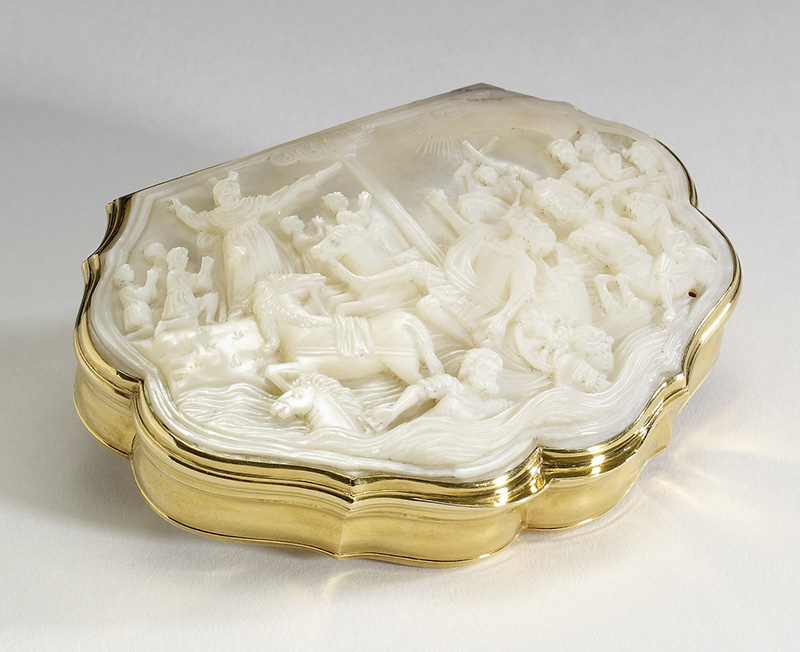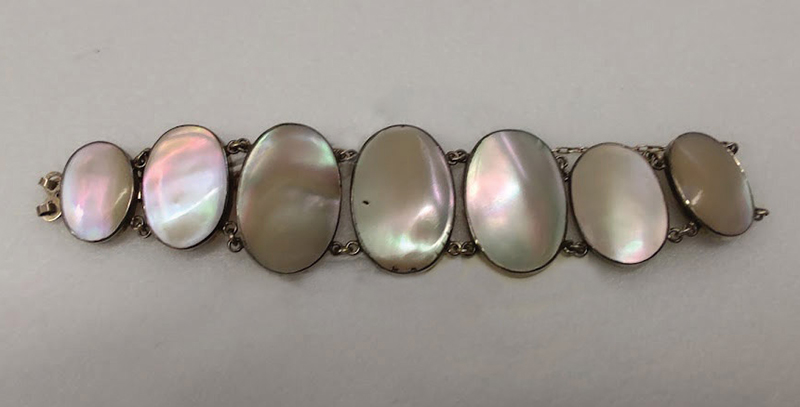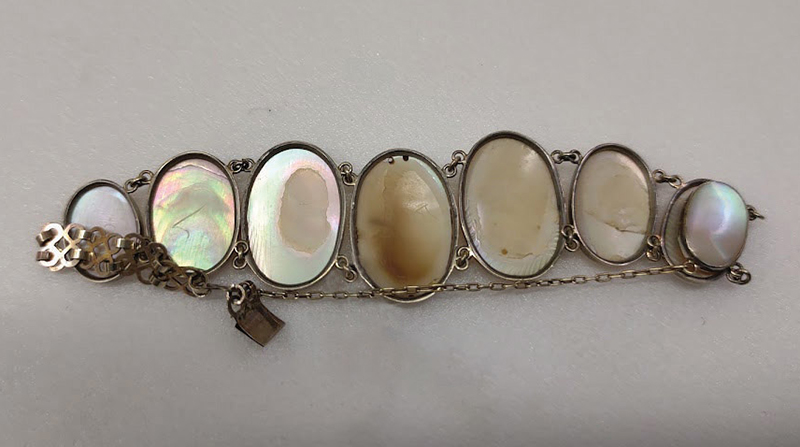Manipulating Mother-of-Pearl: An 18th Century Coque de Perle Bracelet
by Cynthia Kok
Mother-of-pearl was a material with great craft potential. Like pearls themselves, the shell consists of layers of nacre, an organic-inorganic composite produced by mollusks. Iridescent, nonporous, lightweight, and chemically inert, mother-of-pearl possessed properties rarely found in a single material and impossible to replicate in any man-made substance in early modern Europe. In the 17th and 18th centuries, makers used it experimentally and diversely, integrating the unusual properties of mother-of-pearl into a continuum of objects, from nautilus cups (figure 1) to engraved snuffboxes (figure 2) to faux pearls.
A 1783 set of English wedding jewelry, for example, is composed of 25 pearlescent gems, linked together by simple gold chains (figures 3–4). The gems, which appear like unusually large blister pearls, are actually a type of mother-of-pearl cabochon called coque de perle, which used a nacreous veneer to suggest a large gemstone. The popularity of coque de perle hints at mother-of-pearl’s transition from a valued rarity, exemplified by 17th-century nautilus cups, to a semi-precious, but abundant, resource with which makers experimented.
Although jewelers in the 18th century continued to preserve pearls in their natural forms—Baroque pearls have always been valued and often used as a foundation for imaginative jewelry—they considered mother-of-pearl a more affordable resource that could be molded and reshaped. To create the cabochon, jewelers stripped the nautilus shell to its nacreous layer before polishing a section of it to a thin dome.1 The dome is then filled with a binder, to stabilize the nacre, and set either with a flat back to appear like blister pearls or paired with another dome to mimic a rounded pearl. Pierre de Rosnel’s 1667 book on gemology described a “nacre de perle [which] is strictly speaking the node at the end of a shell…in no way similar to the pearl…they are rarely found perfect…most of them being flat or rough, or striped on the surface…and only used in mechanical works.”2 By the latter half of the 17th century, the Dutch East India Company had imported enough nautiluses that prices fell.3 Makers began reshaping the nautilus shells into a fashionable veneer instead of focusing exclusively on preserving its spiral form.
Coque de perle developed as an alternative to more expensive pearl objects in late-17th-century Netherlands. Actual giant pearls were rare and prohibitively expensive. For example, jeweler Thomas Cletscher purchased a pair in 1632 for a thousand pounds.4 In contrast, the value of coque de perle lay in the crafting of the material, rather than the material itself. Coque de perle was difficult to manufacture, and accounts of the process noted that only one or two plaques could be made from a single shell.5 Even well-crafted coque de perle jewelry could be particularly fragile. Examining the back of the wedding bracelet more closely (figure 4), we can see the chipped mother-of-pearl veneer (most visible in the third roundel from the left) which reveals that only a very thin layer of shell concealed the stabilizing cement.
This type of veneer jewelry became increasingly available in cities across Europe. A 1716 advertisement in the Amsterdamse courant included a necklace with “large half pearls, back with mother-of-pearl,” possibly referring to the coque de perle technique.6 In a 1773 theft from a fancy goods stall, the robber took “fine coque de pearl necklaces and earrings.”7 As evident in period advertisements, jewelers, shopkeepers, and consumers were all highly aware of differences in the materials. They distinguished between pearl and mother-of-pearl, naming each material specifically, for example, in a listing for “one pair of bracelets of pearl” and another for “one bracelet of mother-of-pearl, with small diamonds in between both set in gold and enameled.”8 Mother-of-pearl may be chemically the same material as pearls, but it had been categorized as a distinct substance, more of a craft material than a precious gemstone. This distinction rendered mother-of-pearl as a flexible resource for makers to manipulate into novel forms.
Mother-of-pearl’s mutable surface is one of its defining characteristics. The material cannot be understood through textual description or pictorial representation; a first-hand examination is required to grasp its tactility and vividness. A Decorative Arts Trust Research Grant provided an invaluable opportunity to conduct necessary on-site examination of objects like the coque de perle bracelet to better understand their materiality. Likewise, early modern European makers could only develop their knowledge of mother-of-pearl’s material capabilities through hands-on experimentation. By considering mother-of-pearl’s use beyond the nautilus cup and collecting cabinet, we can re-situate the material as a commercial resource and an artistic medium, and develop a more nuanced understanding of craft practices in the early modern era.
- Kathleen Kennedy, “From Coque de Perle to Osmeña Pearl: A Short Documentary History,” Journal of Jewellery Research 3 (March 2020): 23.
- Pierre de Rosnel, Le Mecure Indien, ou, Le trésor des Indes (Paris: Robert Chevillion, 1668), 43-4.
- Hanns-Ulrich Mette, Der Nautiluspokal: wie Kunst und Natur miteinander spielen (Munich: Klinkhardt & Biermann, 1995), 35-6, 145-6.
- Karina Corrigan, Jan van Campen, and Femke Diercks, Asia in Amsterdam: The Culture of Luxury in the Golden Age (New Haven: Yale University Press, 2015), 172-3.
- Johann Beckmann, History of Inventions and Discoveries, vol. 1, trans. William Johnston (London: J. Walker and Co., 1814), 266.
- “Amsterdamse courant.” Amsterdam, 14-01-1716, p. 2. Accessed 23-08-2022.
- “Oprechte Haerlemsche courant.” Haerlem, 17-06-1773, p. 2. Accessed 25-08-2022.
- “Oprechte Haerlemsche courant.” Haerlem, 14-01-1687, p. 2. Accessed 23-08-2022.
Cynthia Kok is a PhD candidate in the Yale University Department of the History of Art and the 2021-23 Kress Institutional Fellow at the Leiden University Centre for the Arts in Society.
A print version of this article was published in The Magazine of the Decorative Arts Trust, one of our most popular member benefits. Join today!




